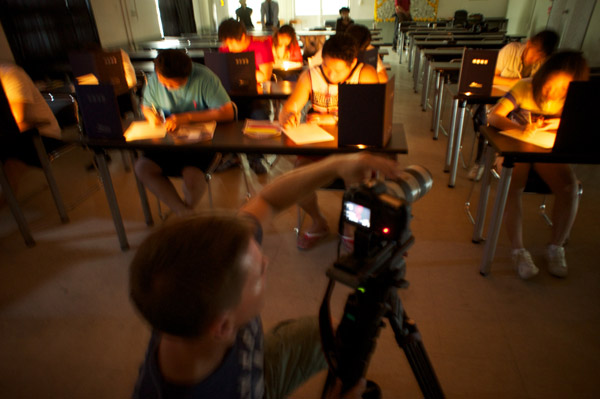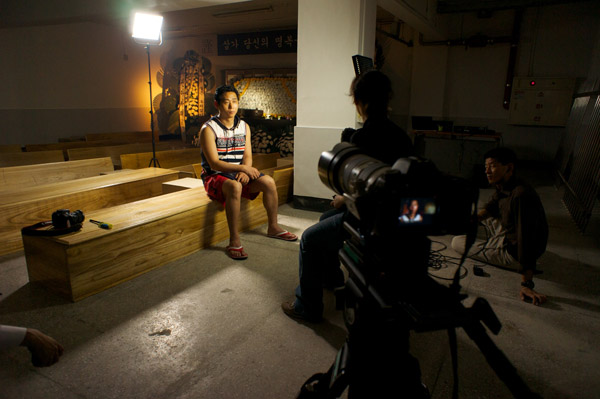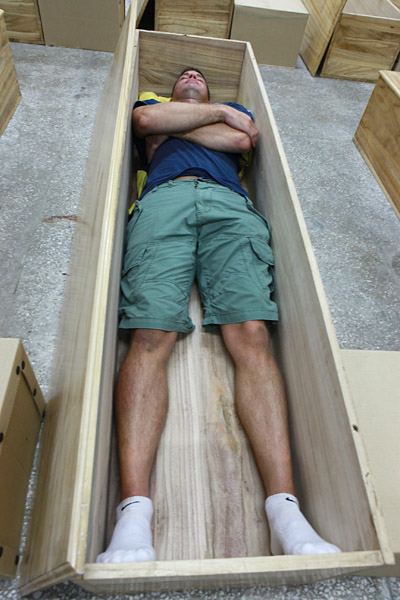Dying To Live from Matthew Allard on Vimeo.
In South Korea, many people “die” to learn how to live. The country’s Coffin Academies may sound strange, but they have become very popular and even large companies like Samsung have made it mandatory for employees to attend. The idea is for individuals to think about what they have done with their life and to try to make it better. South Korea has the highest suicide rate in the developed world and organisers hope that people attending these seminars come out with a better appreciation for life.
Correspondent Steve Chao and I travelled to Daejeon in South Korea to witness one of these coffin academies. I already knew from doing some research what was involved in the process and that most of the seminar was going to be undertaken in very dark conditions. I chose to use a Canon 5D and 7D and a variety of fast lenses to capture the story. The people attending the academy were paying to be there so I needed to be very respectful of their space and try not to interfere with their experience. I was not able to use any lighting other than what was available, making this shoot particularly tricky. I was going to have to shoot a lot of the scenes with nothing more than a few candles providing the ambient light. As much as I love the 5D for its low light capabilities I was wishing I had a Nikon D3x in my kit: the D3x is the ultimate low light camera that can run incredibly high ISOs (up to 20,000) without any noise in the picture.

The seminar started in a normal conference room with overhead fluorescent light. As soon as the attendees had written their own obituaries and how they would like to be remembered, the overhead lights were turned off and only a single small candle provided illumination for each person. Using a combination of fast lenses (mainly a Canon 50mm f1.2) I was able to limit the ISO to no more than 800-1250. As good as the 5D is, anything over about 2000-2500 ISO and you will start to get significant noise in your picture.
The main part of the seminar – where people read out their obituaries and spend time in a real coffin – proved to be one of the most difficult situations I have ever had to shoot in. It was in a pitch black basement with no windows and the only light was coming from less than 20 small candles. It was so dark that it was hard to see with the human eye. The whole process was to take no more than 10-15 minutes.
I couldn’t get people to wait for me to set a shot up, I couldn’t get them to do anything more than once. Everything happened very, very quickly. Having to run as much as 6400 ISO on a f1.2 lens provides major focussing problems. High ISO and super fast aperture also create a lot of noise. I managed to get what shots I could in the little time I had and was fortunate enough to have already placed a GoPro Hero HD camera on the lid of one of the coffins facing down for a shot to show what the participants were experiencing inside the coffin. To provide a tiny bit of light inside it I placed a Switronix LED torch light near one of the participant’s arms.

The interviews were all shot after the seminar on a Canon 70-200 f2.8 US IS II and lit using Litepanels 1×1 LED panel lights with Dedo lights illuminating the background.
I also spent time in the coffin once the seminar was over to experience what it is like. In complete pitch black darkness, with no noise for just ten minutes, it was something that really made you think about your life.

I was happy with the end result given the conditions and time I had to shoot this story. Without using a DSLR it would have been virtually impossible to shoot – my Sony XDCAM HD would have been useless in these lighting conditions.
One other thing I’d like to mention. Whenever you are shooting, try and shoot the material as if it was going to be the finished product. Too many people these days just say “I’ll fix it in post.” DSLR cameras may have huge sensors but they can’t capture in RAW. h.264 has a far lower bit rate and way less colour information than a camera such as the RED which can shoot in RAW. What this means is that DSLR cameras have far less tolerance to change things such white balance, black levels and contrast than cameras that can shoot RAW. Yes, there are lots of picture styles out there designed to give you a very flat neutral image with reduced sharpness and saturation, but unless you are careful you can end up with an image that you may not be able to use. Remember anything that you are adding in post is artificial……whether it be more saturation or sharpness. Shooting in a neutral picture style may be fine for people making short films, but in the world of news people are watching on HD television sets and expect to see vibrant, sharp images. The lesson here is to think about what you are aiming for and who your audience is. Post-production is all well and good, but the less time you have to spend doing it the more time you can spend shooting. Trying to get it right when you shoot it is far more rewarding than spending hours trying to fix it in post. The lesson for today: In news as in life, it is better to make the most of the moment than regret messing up once you get to the end.
About Matthew Allard, Aljazeera Senior Field Cameraman, Kuala Lumpur:
Matt has been a Camera/Editor in TV news for 20 years, previously working for both Channel 9 and Channel 10 in Australia. Twice Network Ten Australia’s cameraman of the year as well as being a Walkley Finalist for outstanding camerawork in 2006 (for coverage of the Cronulla Race Riots) and a Logie Finalist for outstanding news coverage 2006 (Bali 9). He has covered news events in more than 30 countries, from major sporting events to terrorist bombings. Based out of the Kuala Lumpur broadcast centre in Malaysia he is an avid user and follower of new technology, shooting stories on HD broadcast cameras as well as new Canon DSLR’s.





